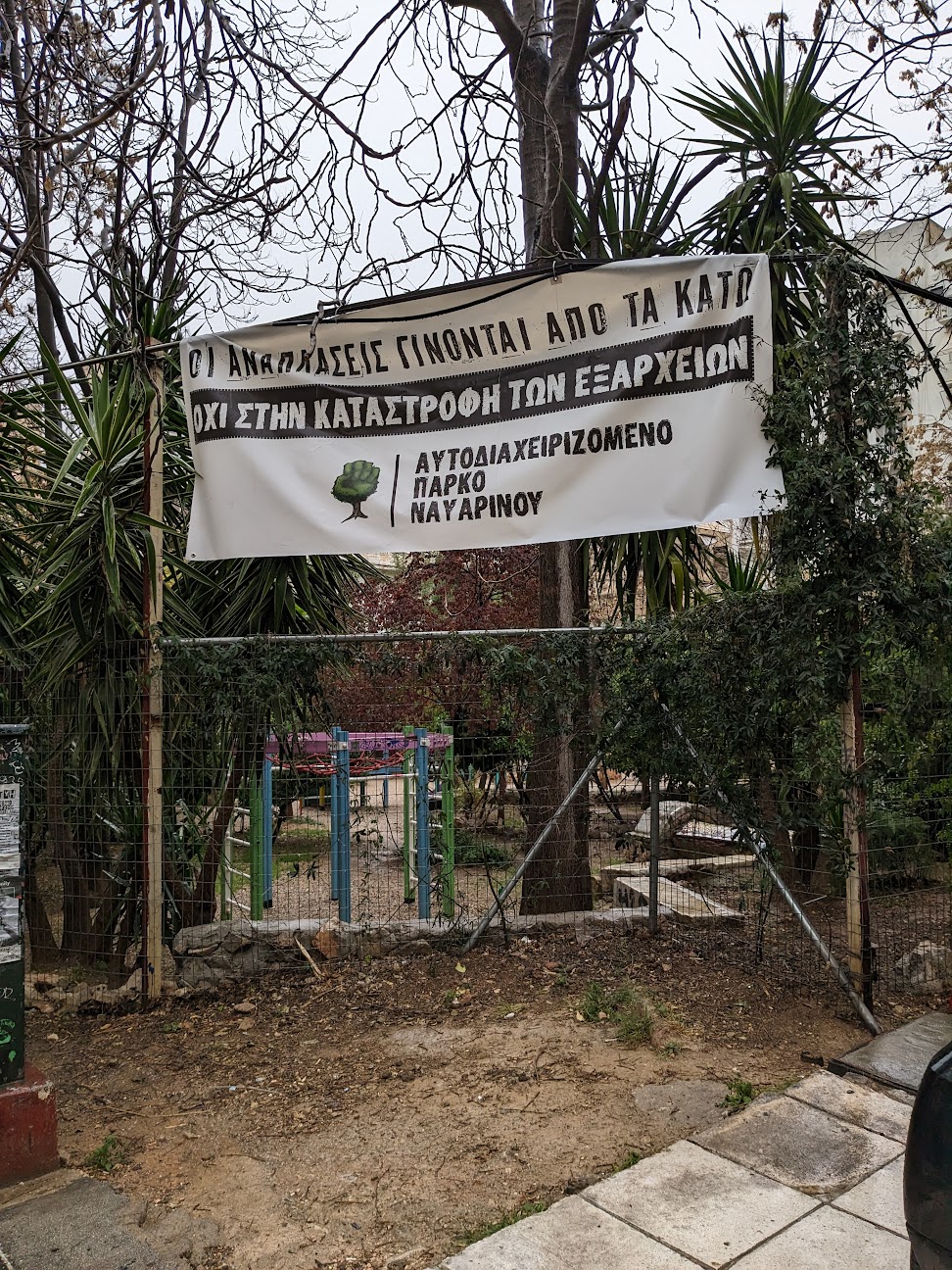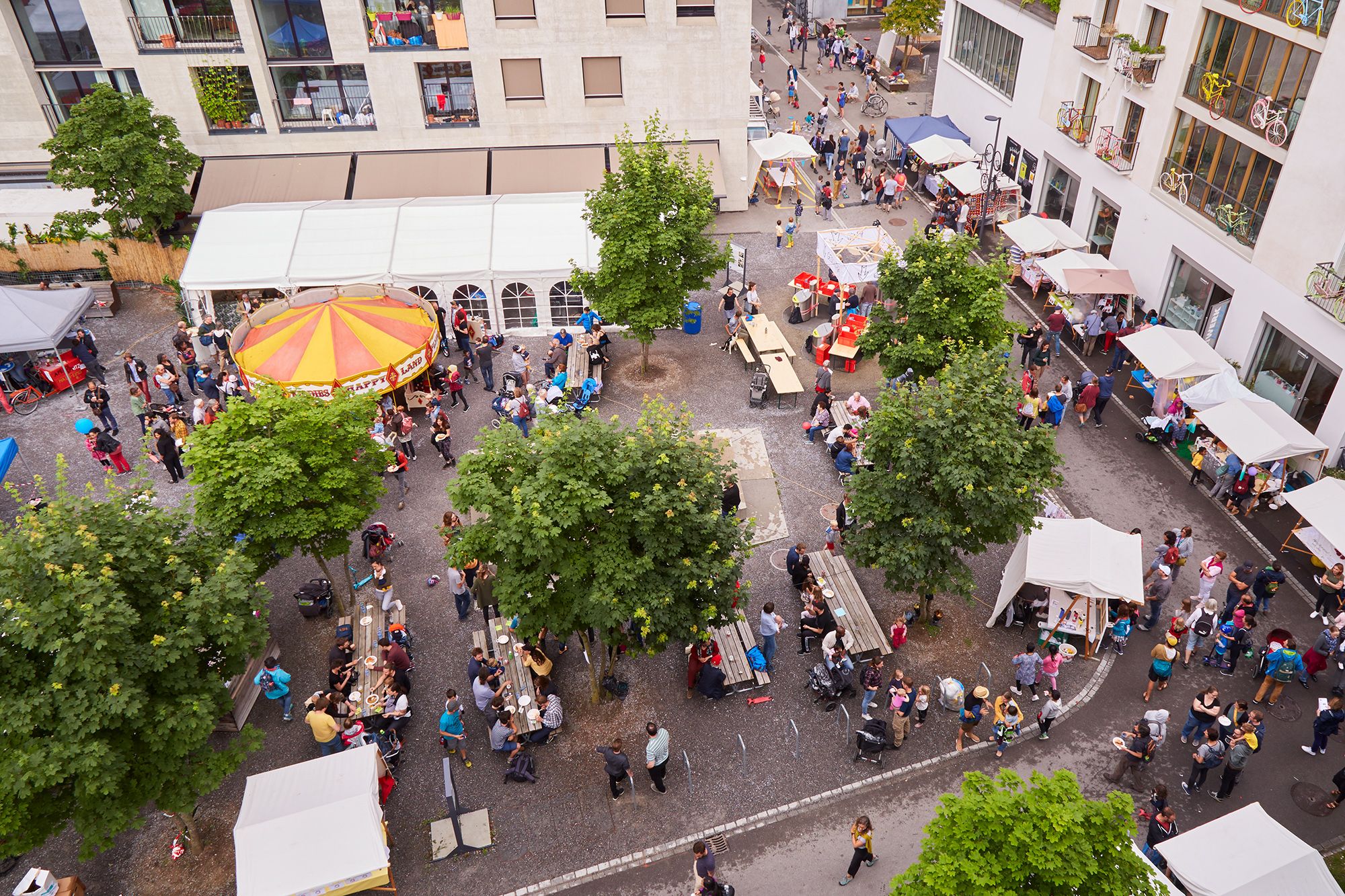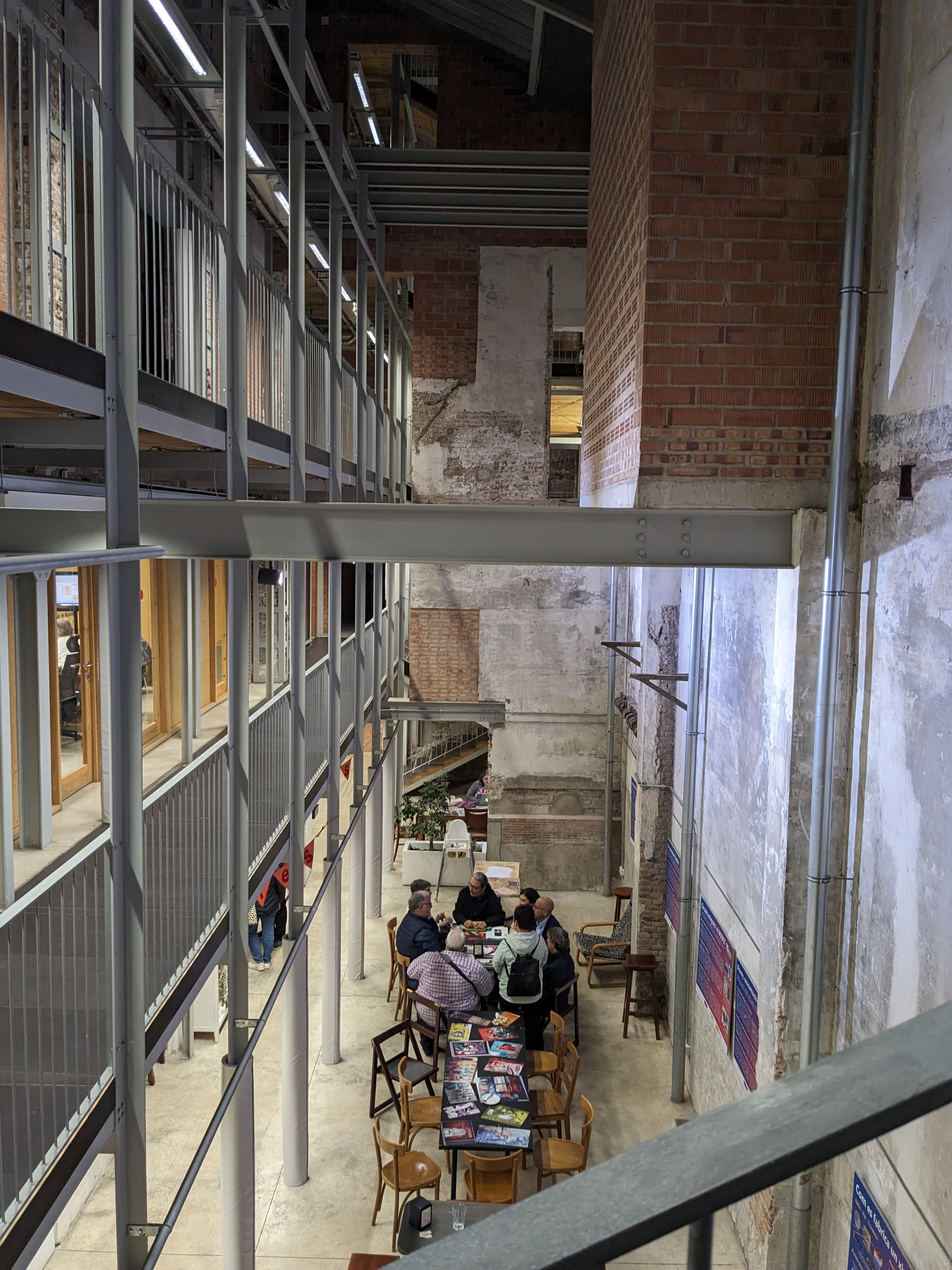
Navarinou Park
Created on 03-10-2023
Background
The neighbourhood of Exarcheia, where the park is located, is one of the most – if not the most– politically active areas in Athens and is traditionally home to intellectuals and artists. Since the 1970s, it has been in the centre of social movements, serving as a breeding ground for leftist, anarchist and antifascist grassroots and alternative cultural practices (Chatzidakis, 2013). Given its location in the centre of Athens, the neighbourhood is lacking green and open spaces.
The site of the park has a long history of negotiations regarding ownership and use, dating back to the 1970s. During that time, the Technical Chamber of Greece (TEE) purchased the 65-year-old medical clinic with the purpose of demolishing it and constructing its central offices. Although the building was eventually demolished in the 1980s, TEE never constructed its offices. In the 1990s, the site was offered as part of an exchange between the TEE and the Municipality of Athens for the development of a green space, but this agreement did not materialise. Instead, the TEE leased the plot for private use, and turned it into an open-air parking space (Frezouli, 2016).
The termination of the lease in 2008 coincided with a major social movement triggered by the assassination of a 15-year-old boy, Alexis Grigoropoulos, at the hands of the police. This tragic incident took place in December of the same year, just a few streets away from the site and led to uprisings in many Greek cities and neighbourhoods as citizens demanded the right to life, freedom, and the city through protests and illegal occupations. In response to the rumours about the site’s future construction, the Exarcheia Residents’ Initiative, in collaboration with many grassroots movements, used digital means to issue a collective call for action to reclaim the plot as an open green space. On 7th March 2009, tens of people from the neighbourhood and around Athens occupied the plot and created the 'Self-managed Navarinou and Zoodochou Pigis Park' (Frezouli, 2016; pablodesoto, 2010)
The park as an urban commons urban commons resource
The operation and development of the park, in terms of its uses and infrastructure, is collectively shaped by the appropriating community of commoners, consisting of activists and local residents, without any contributions from the state, municipal or private organisations. Hence the activities and interventions within the park are evolving with the joint efforts and time, work, skills and financial resources of the commoners.
In this regard, the transformation of the space from a parking lot into its present form has followed a dynamic process, that keeps adapting to the changing resources, needs and challenges created by the social and urban circumstances. The initial intervention involved replacing the concrete ground with soil and planting flowers and trees donated by the community. Subsequently, a small playground and seating areas were constructed, forming an open amphitheatre (Parko Navarinou Initative, 2018b). This infrastructure served as a base for organising public events such as cultural activities, public discussions, live concerts, film projections, and children’s activities. At a later stage, educational workshops on agriculture were also introduced (Frezouli, 2016). Many of the activities brought about spatial transformations within the park, including the creation of community gardens or sculptures, murals and installations.
In its most recent phase, the park has been transformed into a “big playground” for all the residents housing a variety of greenery, such as the urban gardens, as well as seating and gathering urban furniture, including benches and tables. The park now features several playground equipment suitable for both children and adults, such as swings, playing structures, a basketball court, and a ping pong table. Additionally, safety has been enhanced by improving the lighting and adding a fence (Parko Navarinou Initative, 2018a).
Commoners and commoning
To thrive as a bottom-up initiative, the operation and governance of the park are based on several forms of mobilisation that extend beyond the initial public space occupation. Among the various forms of commoning undertaken, activism, collective action, network creation and co-governance have been vital for Navarinou Park. These social processes have been supported by other participatory or community-based practices, such as public campaigns, co-construction and co-creation activities (Frezouli, 2016).
Since its beginning, the initiative has established an open assembly as the main instrument for decision-making on operational and infrastructural matters related to the park. This ensures that the park remains a shared resource, fostering a sense of belonging and strong bonds among the commoners. The assembly sets the rules and practises that constitute the institutional arrangements of the park, following a governance model based on horizontal democratic processes driven by the principles of self-management, anti-hierarchy and anti-commodification. The assembly is open to any individual or group that wishes to participate. However, throughout the park’s lifetime, only a small core of people remains permanently committed to the initiative. This groups is cohesive in terms of social incentives, activist ideals, and social capital, which reduces conflicts during decision-making processes (Arvanitidis & Papagiannitsis, 2020).
However, beyond addressing issues such as maintenance, organisation of events and infrastructure interventions, the assembly has been confronted with several challenges of both internal and external character, necessitating adaptability and rule-setting. One key challenge is the continuous commitment required for attending meetings and carrying out the daily tasks, which relies entirely on voluntary engagement. The gradual decrease in engagement, reaching its peak in early 2018 and even threatening the park’s survival, prompted the core team to seek new forms of communication and involvement to attract more residents to use and engage with the space. (Arvanitidis & Papagiannitsis, 2020). The idea that emerged focused on addressing the lack of play-areas in the neighbourhood by transforming the park into a large playground that would appeal to families, parents, children and the elderly. This vision was realised through a successful crowdfunding campaign (Parko Navarinou Initative, 2018a) that used the moto “play, breath, discuss, blossom, reclaim, live” to convey the key functions of the park.
Another significant challenge, especially during the first years of the initiative, was external delinquent behaviour, including vandalism, drug trafficking, and problems with the police (Avdikos, 2011). After several negotiations, the assembly decided to install a fence around the park to improve the monitoring and maintenance of the space while still keeping it open to everyone during operational hours and activities.
Impact & Significance
Navarinou Park is considered to be a successful example of the bottom-up transformation of an urban void into an urban commons among scholarly discourses (Arvanitidis & Papagiannitsis, 2020; Daskalaki, 2018; Frezouli, 2016; pablodesoto, 2010). It not only provides environmental benefits delivered through high quality green spaces, along with a variety of social and cultural activities for the residents of Exarcheia but, most significantly, it has "motivated and empowered residents, offering a great sense of pride and providing incentives for enhancing social capital and social inclusion, community resilience, collective learning and action"(Daskalaki, 2018, p. 162). The park demonstrates a successful example of urban commons in continuous growth, where social capital and solidarity are the motivating goals that drive both collective management and the ability to overcome challenges over time:
“If there is one thing that motivates us to move forward, it is the impact of our endeavour not only in theory but in practice: in the constructive transformation of behaviours, awarenesses, practices and everyday lives. It is up to us to seize the new opportunities that open up before us. If we ourselves do not struggle to create the utopias we imagine, they will never exist”. (Parko Navarinou Initative, 2018a)
A.Pappa. ESR13
Read more
->

Mehr als wohnen – More than housing
Created on 21-10-2024
The context
In Switzerland, housing cooperatives are private organisations, co-owned and self-managed. The city of Zurich has a rich history of housing cooperatives and non-profit housing associations dating back to the early 20th century, constituting 25% of the city’s housing stock. As was the case in other central European cities, housing cooperatives in Zurich emerged in response to a housing shortage and the unavailability of affordable prices. The model for establishing a housing cooperative is straightforward: individuals come together to form a cooperative, becoming shareholders. The cooperative builds housing and rents it to its members at cost prices. Since no profits are generated, and the land value is not increased for resale, the gap between cooperative rents and open market rents widens significantly over time. Historically, members of housing cooperatives were often affiliated based on profession or religion, such as public officers, for example.
The foundation of this housing cooperative model was laid in 1907 when a law was enacted, assigning responsibility to the municipality for providing ‘affordable and adequate housing’ (Hugentobler et al., 2016). The first housing cooperatives were established in 1910, and the Allgemeine Baugenossenschaft Zürich, ABZ, currently the largest cooperative in Switzerland, was founded in 1916. In the 1970s, cooperative housing faced a decline due to poor maintenance. However, a revival occurred in the 1980s when a new cooperative movement emerged. The new cooperatives aimed to break away from the rigidity, institutionalisation, and outdated principles of traditional housing cooperatives. The discourse of this movement emphasized the need for more sustainable living environments, affordable and non-speculative housing, and social integration. In 2011, a city-scale referendum took place, resulting in the population voting in favour of a law aiming to increase the proportion of non-profit housing to 33% of all housing (not just newly built homes) in the city by 2050. This legislation mandates the city of Zurich to establish a framework and instruments to support non-profit housing.
Process
In 2008, the Public Works Department of the city of Zurich and the cooperative Mehr als Wohnen launched an international competition for ideas. This initiative was part of the festivities marking 100 years since the inception of cooperative housing in Zurich (“Mehr als wohnen - 100 Jahre gemeinnütziger Wohnungsbau”). The competition sought innovative ideas about the future of non-profit housing. Out of 100 submissions, 26 teams of architects were selected and were invited to submit an urban development concept for the Hunziker Areal, including designs for residential buildings. A young team won the master plan competition, aiming to integrate diverse architectural proposals into a cohesive urban development concept. A subsequent dialogue phase ensued, during which architects and project operators collaborated to integrate various concepts into the master plan. Future residents and the broader public participated in 3 to 4 events annually, engaging in discussions about the neighbourhood’s future. The dialogic process continued until construction started in 2012.
Land
The four-hectare plot of disused industrial land at the Hunziker Areal in the Leutschenbach district was made available for building by the city administration. The site formerly housed a concrete industry until the 1980s when the company closed, and the city of Zurich acquired the land. Due to a law approved by a referendum in 2011, the city of Zurich is obligated to prioritize non-profit housing over selling land to the highest bidder. In 2007, the city council signed an agreement with the cooperative for a lease of 100 years, with the possibility of renewal. As part of the agreement, the cooperative must adhere to various conditions, including calculating rents based on investment costs, subsidizing 20% of the housing units, providing 1% of the ground floor for neighbourhood services at no cost to the city, allocating 0,5% of construction costs to local art projects, meeting high energy standards in construction, and launching an architectural competition for the new housing buildings. The cooperative pays an annual fee for the use of the plot, which is adjusted every five years, according to the cost-of-living index and interest rates. This fee also considers the space provided by the cooperative and the subsidies offered to low-income residents.
Funding
Following the agreement with the city council for the land, cooperative members embarked on securing funding. The members of the cooperative had to bring the 5,4% of the initial capital, with the remaining other 0.6% covered by the municipality. The founding cooperatives of Mehr als Wohnen leveraging their existing resources and expertise, contributed half of this amount. The other half was covered by the future residents, amounting to CHF 250/m2 as their member equity. For low-income households or elderly people, the city’s social services could cover this amount.
The remaining funding was obtained from three levels of administration: city, canton and federal. At the federal level, the Federation of Swiss Housing Cooperatives provided a CHF 11 million loan through its revolving fund, offering a twenty-year term with a 1% interest rate. Additionally, at the federal level, CHF 35 million was secured through a bond loan with fixed interest rates for the first twenty years, facilitated by the Bond Issuing Cooperative for Limited Profit Housing (Emissionszentrale für gemeinnütziger Wohnbauträger/ Centrale d’émission pour la construction de logements – EGW/CC) and public subsidies. EGW functions as a financing instrument for housing projects of public interest, guaranteeing loans through the Swiss Confederation (Federal Bureau of Housing) to provide security for investors. Nonprofits benefit from significantly more advantages compared to comparable fixed mortgages with the same terms. At the cantonal level of Zurich, the project secured a CHF 8 million loan, and at the municipal level, another of CHF 8 million, both with fixed interest rates. However, instead of paying the interest to the city and canton of Zurich, the cooperative uses this amount to subsidize 20% of housing units (80 of the 370 apartments). To complete its financial planning, Mehr als Wohnen also secured a CHF 8 million loan from the city of Zurich’s pension fund, with a fixed interest rate. With this combination of sources, providing 27% of the total investments, the remaining necessary financing was obtained from a consortium of four banks through traditional mortgage loans.
Inclusion mechanisms
Mehr als Wohnen employs a mechanism commonly used by many Swiss housing cooperatives, that allows its members to transfer their savings to the cooperative instead of keeping them in traditional banks. These “member funds” constitute part of the cooperative’s capital, meaning that the larger the member funds are, the less the cooperative will rely on mortgages in the future. Members who invest in their cooperatives benefit from a higher investment return compared to what they would receive at a conventional bank. The cooperative also maintains an internal solidarity fund, aiding in financing solidarity projects or assisting families facing difficulties in paying their equity. Every household and commercial store contributes a monthly amount, ranging from 10 to 30 CHF, depending on their income. Through this fund, the cooperative can reduce monthly rents for low-income households, cover maintenance or adaptation fees, organise events, and provide financial support to cooperative projects in the neighbourhood or abroad.
Design innovations
The project is planned for a mixed-residential population and a diverse mix of uses. The term “more” in its name signifies the aim of creating a sense of community and belonging, which is reflected in the interior as well as exterior spaces. The concept revolves around reducing private spaces, with an average of 35 m2 per person for tenants, while providing increased communal areas, such as roof terraces, children’s playgrounds, and car-free spaces. In terms of private spaces, Mehr als Wohnen incorporates various housing typologies to accommodate diverse needs, including cluster apartments, satellites, family apartments, large units capable of housing 7 to 12 individuals, studios and spaces that can be adapted to different purposes. The apartments range from 2 to 7.5 rooms[1], offering a broad spectrum for exploring different residential possibilities. These combinations of spaces highlight diverse household compositions and lifestyles, acknowledging the simultaneous desire for privacy and communal living. Most of the apartments have 4-4.5 rooms (37%), followed by 3-3.5 room apartments (26%), and larger apartments with 5.5 rooms or more (22%). Apartments with 1 to 2.5 rooms account for only 15%, which is a smaller percentage compared to the city of Zurich, where this category represents 34%.
lusion
The aim was to create a “lively quarter where people like to live, work and spend their free time” and should be offered to people from “all social strata” (as stated in Mehr als Wohnen’s mission statement). The aim of the project was that the composition of the residents in the project should reflect the distribution of different households from the canton of Zurich as a whole. In order to achieve a mixed population, the cooperative collaborated with various institutions. A total of 10% of the apartments were reserved for the Züriwerk Foundation, supporting people with impairments; the Domicil Foundation, assisting families with immigrant backgrounds in finding housing; the Woko Cooperative, aiding teachers and students; and the ZKJ Foundation, finding homes for children who could not live with their families.
[1] In Switzerland and Germany, the count of rooms per apartment encompasses more than just bedrooms; it includes any kind of room present in the apartment. The term "half room" typically refers to spaces that aren't fully designated as bedrooms, such as a living room that could potentially be converted into one. It's important to note that bathrooms and toilets are not included in this room count.
Z.Tzika. ESR10
Read more
->

Lleialtat Santsenca Civic Centre
Created on 18-10-2024
La Lleialtat Santsenca is a community managed municipal facility aiming to the promotion of culture, neighbourhood and cooperation. The space aspires to be a place of reference in the neighbourhood, hosting initiatives and activities open to everyone that promote community life through participation, strengthening the social bonds and creating networks and partnerships (La LLeialtat Santsenca, n.d.).
The historic context
The original building, designed by the architect Josep Alemany i Juvé, was constructed in 1928 to host the Cooperativa Obrera La Lleialtat Santsenca, which was founded in 1891 and was one of the oldest working-class cooperatives in the neighbourhood of Sants. The building embodied the spirit of solidarity among the working class and became a hub for social exchange and socio-political activity, housing a food shop, a bakery, a café, a boardroom, small theatre and library, along with storerooms and administrative offices. (From Workers’ Cooperative to Civic Center, the Lleialtat Santsenca Building in Barcelona, n.d.).
During Franco’s regime, the building was expropriated and reopened in 1941 under Falangist management. In 1950 the cooperative was merged with another cooperative called La Flor de Maig and the building was used as a nougat factory -on the ground floor- and dance hall called Bahia -on the first floor-, becoming a musical landmark for the entire city of Barcelona during the 50s and 60s before eventually shut down by the Barcelona City Council in 1988. In December 2009, after years of abandonment, the building was reclaimed by sixty neighbourhood entities, who came together to recover it as a public asset (Somerville, 2020).
The coordination of the neighbourhood groups to reclaim this heritage asset occurred as a result of a long tradition of grassroot movements against urban regeneration plans, especially mobilised in the neighbourhood of Sants, such as the “Save Sants” in the 1970s (originally referred to as “Salvem Sants”). The 2008 crisis yield a renewed wave significantly directed towards the topic of alternative economies through neighbourhood-based associativism (Somerville, 2020). In this breeding context, the neighbourhood of Sants retained a very active character, aiming to recover iconic, often industrial sites of heritage back to public use and social benefit, reviving the original principles of support and solidarity of the working-class populations.
The building renovation
In 2012, BIMSA (Barcelona d’Infraesreuctures Municipals) launched a competition for the renovation of the building, that was won by the architectural studio H-Arquitectes. The renovation was based on three fundamental principles: highlighting the historic value of Lleialtat Santsenca; maintaining and reusing the maximum possible original building and materials; and embracing the collaborative processes driven by neighbourhood organisations of reclaiming and recovering the building. The restoration involved demolishing unusable elements while preserving structural bodies, creating a large central atrium for light, ventilation and visibility and incorporating features for sustainability, such as passive climate control, solar capture and minimal mechanical air conditioning. (Centre Cívic Lleialtat Santsenca 1214 - H ARQUITECTES, n.d.).
The legal context
Along with a very active social movement towards associativism, Barcelona has a well-established history of public facilities managed by citizens’ associations. This has been facilitated through public-community collaboration that are established and protected by Article 43 of the “Carta Municipal de Barcelona” which states that:
“Non-profit citizen entities, organizations, and civic associations may exercise municipal competencies or participate on behalf of the City Council in the management of services or facilities whose ownership belongs to other public administrations. The civic management of municipal competencies can be used for activities and services that can be managed indirectly, is always voluntary and not-for-profit, and is awarded by public tender when there are several entities or organizations with identical or similar characteristics.” (Diari Oficial de La Generalitat de Catalunya, Carta Municipal de Barcelona, 1999, p. 219).
The principle of civic management has been further strengthened by the creation of networks of associations throughout Barcelona, such as the Plataforma de Gestió Ciutadana[1], which since 2009 is committed to protect and promote all the associations that manage or aspire to get involved in the management of a public facility. Another network of community-managed spaces is Xarxa D’espais Comunitaris (XEC) that coordinates different projects to promote transparency and mutual support through generating meeting points, training and self-organisation (XES - XEC, n.d.).
The community management
Within this context, the space is managed by a nonprofit organisation, called Coordinadora d’Entitats per la Lleialtat Santsenca, consisted of neighbours, associations and collectives of Sants that share the values of cooperation, community action, respect and freedom. The sixty neighbourhood collectives are incorporated according to their scope in three lines of action: neighbourhood, culture and cooperation. The management model follows a democratic and transparent structure that consists of the Fòrum de la Lleialtat, a collective decision-making tool open to all neighbours and local organisations that wish to participate, as well as operating commissions responsible for community action, economic management, technological support, programming, communication and memory (La LLeialtat Santsenca, n.d.).
The services
Lleialtat functions as a community center, offering various services organised from and in response to local needs. To begin with, the space itself is offered to neighbourhood collectives, either for regular use, in the annual cost of 50€, or for the organisation of special events, such as gatherings, celebrations and concerts, in an affordable cost. The flexibility and adaptability of the space makes it suitable to accommodate any kind of activity. The available spaces offered to the collectives include open-plan and multi-purpose rooms equipped with sound protection, seating and tables, lighting and presentation equipment; a big atrium that serves as an exhibition space as well as the seating area of the Lleialtat café; meeting rooms; a computer room; an auditorium; a terrace; a dance room; (La Lleialtat Santsenca, 2020) and a sustainable mobility vehicle (La LLeialtat Santsenca, n.d.).
As far as the individual neighbours are concerned, the space offers a café, a computer support space, a bank of resources, as well as the daily program organised by the collectives, such as art classes, theatre courses, dance lessons, guided tours, exhibitions and presentations, along with projects for sustainable consumption (La LLeialtat Santsenca, n.d.).
----------
[1] See https://casaorlandai.cat/lassociacio/gestio-ciutadana/plataforma-de-gestio-ciutadana/
A.Pappa. ESR13
Read more
->




